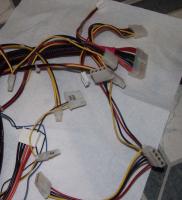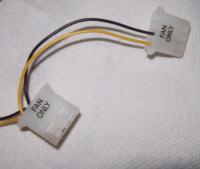4-Way Power Supply Shootout: Vantec, Enermax, ThermalTake, Antec
by Kristopher Kubicki on January 17, 2003 4:31 AM EST- Posted in
- Cases/Cooling/PSUs
Antec TruePower
Antec demonstrates a lot of tried and true practices in its TruePower series PSU. The main selling points of the TruePower series are the dedicated circuits for each line. This may puzzle some readers, but the concept is actually quite simple. Most PC power supplies have 3 main DC feeds from the power supply (+3.3V, +5.0V, +12.0V). Each of these run at a different voltage, and each voltage powers a specific type of subsystem inside the PC. For example, the 5V line is typically used for PCI/AGP devices, while the 12V line is used specifically for motors in the PC (motors are used in devices such as CD-ROMs, hard drives, fans, and virtually anything else that spins). On most power supplies, the 3.3V and the 5V lines are combined on the same transformer. Therefore, when buying a power supply one has to be wary of the combined +5V and +3.3V rating, rather than the individual max wattages of each of these lines. Obviously, if the CPU is hitting its peak usage and drawing as much power as possible, the 5V line runs dangerously low. Over time, this could seriously damage delicate devices. The dedicated transformers on the TruePower allows for a more stable output on the three main lines.
Antec's second technological push is their “Voltage Feedback” technology. CPU's and chipsets have become increasingly demanding in the amount of variance in the DC current. Intel specifically requires less than 5% variance allowance before damage begins to occur on the chip. The problem is that even the leads to the motherboard provide some resistance, which in turn hampers a clean regulated voltage. Antec has countered this problem with voltage feedback. By monitoring the voltage constantly, the circuitry inside the PSU regulates the signal as much as possible. Like dedicated transformers for each line, this feature protects and keeps the powered hardware stable. During the benchmark of these PSU's, we plan on using an oscilloscope to verify these outputs.
|
|
|
|
Form Factor |
ATX Tower |
|
Rating |
430Watts |
|
Onboard Fans |
1 92mm Temperature Controlled Dual Ball Bearing |
|
Other Features |
Dedicated Circuitry |
|
Provisions |
7 full size molex |
|
Connection |
ATX |
The Antec
TruePower is also one of the quietest PSU's on the market. We will get more
into the noise levels of the PSU's later in the review, however. An additional
bonus to thermally controlling its own onboard fans, the PSU also has two
additional connectors specifically designed for case fan control. This feature
has its plus and minuses. While it is certainly a convenient alternative to
buying thermal fans, you may wish to use the connectors on fans situated close
to the power supply. Since cases each have different hot spots, attaching a
fan on the other side of the case from the TruePower may perform inconsistently.
Aside from being one of the most recognized names in the power supply market, Antec has taking a large push to market these units as well. Most brick and mortar retail stores that sell power supplies will probably carry the Antec PSU lines.














6 Comments
View All Comments
Sir Fredrick - Tuesday, January 11, 2005 - link
I would have really liked to see them compare the current draw from the wall, to see how the PSUs compare in terms of energy efficiency.Anonymous User - Friday, August 22, 2003 - link
Switching power supply means the unit can be switched between American 60 Hz, 120 v, and European 50 Hz, 240 v input.Jeff7 - Monday, June 18, 2012 - link
"Switching power supply" refers to precisely what the article says. The "switch" refers to the manner in which the incoming power is handled, not to a physical component on the unit.Plenty of switching power supplies, also called SMPS (switch-mode power supplies), are available without any switches.
Beside me is a switcher supply that accepts 100-240VAC and puts out 12VDC. There are no switches on it.
Some of the circuitry I work with uses small switcher supplies, which take 12-36VDC and put out a solid 12VDC output.
I also work with boosters, which are a kind of switching power supply topology that's capable of putting out a higher voltage than what comes in. These particular ones can take 12VDC and put out about 17.5VDC.
And, I'm looking at a power supply for integration into a new product, and it can handle anything from 85-264VAC at 47-440Hz. Again, no switches on it.
Some of the older or cheaper switcher supplies *do* indeed have the selector switch on them to let them accommodate different voltages. But that's not what makes them "switching" power supplies. The name "switch" being the same is simply a coincidence.
Anonymous User - Friday, August 8, 2003 - link
:):):):):):):):)Anonymous User - Thursday, August 7, 2003 - link
Anonymous User - Thursday, August 7, 2003 - link
PFC, power factor correction, is not just about noise. The square wave shape of current draw of non PFC corrected supplies adds a significant 3rd order harmonics element to the line. This usally is gets diverted by the impedance of power company transformers to flowing in the Neutral line of the power system, which in the past carried almost no current. This nuetral line was installed at a SMALLER size than the mains. There have been buildings burned up in Europe, (which has an older infrastructure) because of this. Also, drawing higher peaks instead of sinusoidal current is less efficient and adds more loss the the wires and transformers, shortening their life and adding more pollution to the world, (ie. more power has to be generated to make up the loss, resulting in more smokestack emissions).